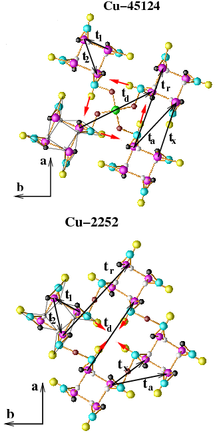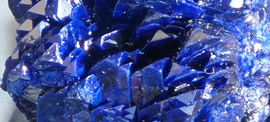page content
Studies of complex magnetic, strongly correlated materials in which lattice degrees of freedom play a significant role
A number of materials with interesting magnetic properties have been
studied with special attention to lattice degrees of freedom. Some experience with the correct application of ab initio molecular dynamics to materials with transition metal
centers has been collected. Careful preparation of structures was often a prerequisite of
these investigations, either because materials that were not yet
synthesized were investigated (see a) Cu4Te5O12Br4) or
because the published structure lacked the precision necessary for
precise DFT study (see b) azurite Cu3(CO3)2(OH)2). In most
materials studied in this area, contact between the material and
many body models was made by determination of effective Hamiltonian
parameters via Nth order muffin tin orbital (NMTO) downfolding or
tight binding (TB).
a) Coupled tetrahedra quantum spin systems
Cu4Te5012Cl4 and
Cu4Te5O12Br4
Cu4Te5O12Br4

The family of oxyhalides which include
Cu2Te2O5X2 (X=Br and Cl)
and Cu4Te5O12Cl4 are
quantum spin systems containing weakly coupled
Cu42+ tetrahedra. The exchange interactions in
the tetrahedra are geometrically frustrated, and thus small changes in
the inter-tetrahedra couplings can lead to unconventional ground
states. In particular, there is experimental evidence pointing to a
closeness of the
Cu2Te2O5Br2 system to a
quantum critical point. While for the
Cu2Te2O5X2-system the
various intra- and intertetrahedral couplings have been determined by
NMTO downfolding [1] and
subsequently confirmed by neutron diffraction experiments [2], the present
work addresses the changes in exchange couplings in
Cu4Te5O12Cl4 with respect
to Cu2Te2O5Cl2 due to the
slightly changed arrangements of the Cu42+
tetrahedra in the crystal structure and the couplings that would be
expected for the hypothetical, not yet synthesized system
Cu4Te5O12Br4. The latter
involved the determination of a likely crystal structure with the help
of Car Parrinello molecular dynamics [3]. For
Cu4Te5O12Cl4, we find that
while the overall nature of the interaction remains the same as in
Cu2Te2O5Cl2, the diagonal
interaction between tetrahedra is strongly reduced while the
out-of-plane interaction is strongly enhanced. The hypothetical
Cu4Te5O12Br4 system shows
in general stronger in-plane intertetrahedral couplings compared to
the Cl system. These results are published in references [VSJ+07,RJV+07].
b) Diamond spin chain azurite Cu3(CO3)2(OH)2
Azurite has been intensely discussed since magnetic measurements found
a 1/3 magnetization plateau [4]. The Cu2+ spins in
azurite are arranged in a diamond chain formed by alternating
Cu2+ dimers and monomers. Several
experiments [4,5] and theoretical interpretations of
experiments [6] have come to completely different sets of
parameters for the underlying magnetic Hamiltonian. This dispute makes
a first principle analysis of this material very interesting.
It turns out that the structural parameters have not been determined
with sufficient precision, which leads to a failure of convergence of
the FPLAPW calculation. Thus, we first carefully relax the light atom
positions before extracting the low energy effective Hamiltonian
parameters. These parameters are determined by a tight binding fit to
the band structure as well as from energy differences between
different spin configurations. The resulting picture for azurite
compares well to experimental observations.
